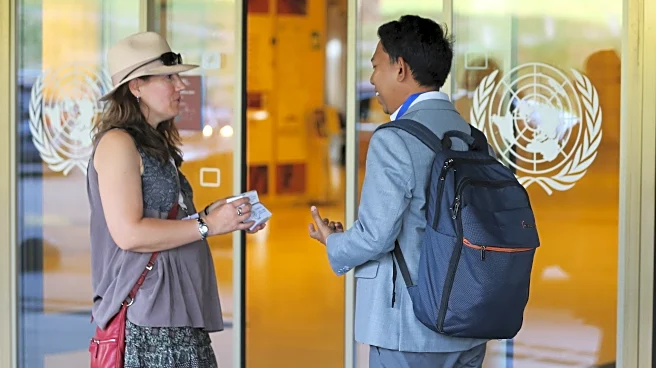What's Happening?
A new animated film titled 'Hola Frida' has been released, focusing on the childhood of the renowned Mexican painter Frida Kahlo. This Canada-France co-production, directed by Karine Vézina and André Kadi, is adapted from Sophie Faucher’s picture book 'Frida, c’est moi'. The film takes creative liberties with Kahlo’s early years in Coyoacán, Mexico City, portraying her as a vivacious child who dreams of becoming a doctor. The animation style is characterized by brightly colored backgrounds and simple character designs, appealing to young audiences. The narrative includes elements of Kahlo's Zapotec ancestry and touches on historical events like the Mexican Revolution. The film also addresses societal norms and Kahlo's defiant personality, albeit in a sanitized manner suitable for children.
Why It's Important?
The release of 'Hola Frida' is significant as it introduces young audiences to the life of Frida Kahlo, a cultural icon known for her unique artistic style and personal resilience. By focusing on her childhood, the film aims to educate children about Kahlo's early influences and the societal challenges she faced. This approach not only makes Kahlo's story accessible to a younger demographic but also highlights themes of empowerment and self-expression. The film's educational intent is evident in its portrayal of historical contexts and Kahlo's aspirations, potentially inspiring young viewers to pursue their dreams despite societal expectations.
What's Next?
The film is set to reach a wider audience with its Spanglish dub, making it accessible to non-bilingual viewers. This choice reflects a broader trend in American media to incorporate bilingual elements, catering to diverse audiences. As 'Hola Frida' continues its theatrical run, it may spark interest in Kahlo's life and work among children and families, potentially leading to further educational and cultural initiatives centered around her legacy.
Beyond the Headlines
Beyond its immediate appeal to children, 'Hola Frida' offers deeper insights into cultural identity and historical narratives. By engaging with Kahlo's Zapotec ancestry and the Mexican Revolution, the film provides a nuanced view of Mexican history and culture. Additionally, the portrayal of Kahlo's subconscious and her interactions with la Catrina introduces young viewers to complex themes of mortality and self-identity, encouraging them to explore these concepts further.













